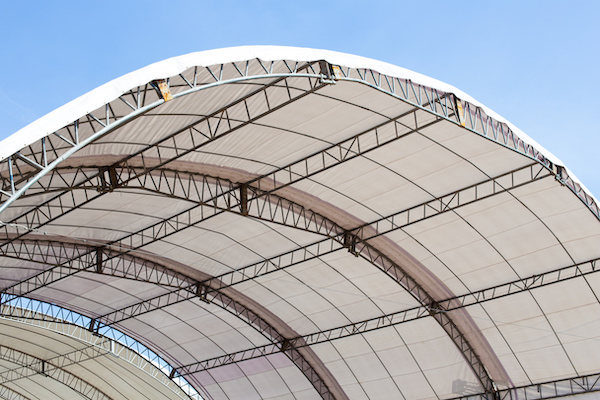
While concrete and wood may seem much more durable, these materials are sometimes ill-fitted in specific settings or situations. Although concrete requires too much work in a building, it’s still likely to get damaged under heavy force. The same applies to wood structures. So, besides expensive construction, there’s also reconstruction to be done afterward in these situations. This is where fabric structures are introduced.
What Are Fabric Structures
As the name implies, fabric structures mainly consist of fabric. However, while it might sound like these buildings aren’t as ideal as traditional ones, many business owners prefer fabric structures for reasons, such as:
- Having a shorter construction time
- Adaptability
- Cheaper costs, and
- Environment-friendly
Furthermore, despite being made of fabric, these structures are engineered to be just as durable as traditional buildings. And working alongside multiple fabric options, many are supported by frames that only change in design but not durability.
Uses of Fabric Structures
Although it’s still a relatively new concept, many business owners are starting to integrate fabric structures into the market. Because of this, you can typically see these buildings used in settings, such as:
When incorporating building designs to having an office job, the first thing on your mind probably leans more towards skyscrapers or blocky structures. Steel and concrete are commonly used for this kind of design.
Before they get started, construction workers must lay out a foundation first to level the groundwork and to set up scaffolding for the building itself. Give or take a year or so; it’s already normal for these buildings to take a lot of time. But despite the careful thought poured into these projects, business owners are slowly turning to fabric structures as modular office buildings for a remote job site.
It’s time to discuss how having a fabric structure as a workplace can benefit remote office workers. As pointed out earlier, fabric structures are environmentally friendly. Although this quality could be about the minimal site preparation for foundations, knowing how to maximize natural light is another reason.
Compared to solid wood or concrete, the fabric is translucent enough to pass through natural light. But what makes it so different from artificial LED lighting? It makes the workplace appear bright and expansive, for one. Because it seems wide, you won’t feel restricted. Without that nagging feeling of restraint, it could boost your comfort while working.
Being stuck in one place is likely to skew your sense of time. Those who work in office buildings without any windows nearby tend to lose track of time. With nothing but the artificial light on your back, it can also cause you to appear paler than average. However, you won’t have this kind of problem while working in a fabric building.
Since natural light is your only source of illumination for most of the day, you can keep track of how much time has gone by. Therefore, pushing you to be more focused and productive in your work. And it doesn’t hurt that the sunlight changing as the day goes by may give your office a more ‘homely’ feel.
- Equipment And Transportation Storage.
Manufacturers tend to have an issue with storing their equipment and products, especially those who are still relatively new to the business world. Because other than investing in a plot of land to set up where the manufacturing takes place, they also have to handle maneuvering their equipment inside the building.
Although it’s for comfort and accessibility, choosing to have a vast space to set up your storage building tends to be extremely expensive. That’s why you may find some business owners purchasing as little space as they can, instead. But clearly, this can lead to a cramped working environment for both workers and equipment alike, which raises the risk for everyone involved.
However, utilizing fabric structures can significantly reduce this kind of danger. Since they allow natural light into the environment, there won’t be any problems if power outages ever occur, especially if it’s in the middle of the day.
As for space, that will never be an issue because, as mentioned earlier, fabric structures are considerably cheaper than traditional buildings. Without using too many materials other than fabric and steel frames, the building phase won’t take that long, as well.
Furthermore, it’s far easier to make adjustments whenever you want to widen the storage building because all you need to do is hire someone to do just that to the steel frame and add more fabric to the structure itself. Therefore, granting every worker and equipment the space they need to function smoothly.
Besides acting as the ideal venue for manufacturers and office workers alike, fabric structures are also perfect for an event, be it a concert or a wedding ceremony. Because instead of fighting tooth and nail for a reservation in a highly acclaimed building, you could simply look for open areas like parks or beaches to set up with how adaptable fabric structures can be.
On top of that, you can expect high-quality acoustics from this kind of building. Since it’s made of fabric through and through, there’s only minimal reverberation allowed, especially from the interior. While buildings made of concrete tend to tremble against any bass volume, fabric structures don’t have that level of reaction. Therefore, leaving their surrounding equipment unaffected.
Bring It In
Building construction has come a long way in terms of the materials used. Although traditional buildings have been around for some time, many still found ways to search for other options to fulfill what concrete and wood can’t do. And they found that through the use of fabric structures.
via https://www.AiUpNow.com
January 3, 2022 at 04:09AM by admin, Khareem Sudlow
